
“I would welcome the opportunity to kill the canard that I scorn my home town, which gave so much to me. Although I live in the East, I remain an aggressively and sometimes abrasively Indianapolis person, and will remain such until I die.”
—Kurt Vonnegut in a letter to Robert Deautels, August 31, 1987
The Kurt Vonnegut Museum & Library (KVML), a nonprofit organization “championing the literary, artistic and cultural contributions” of the writer, is housed in a pleasant brick building in downtown Indianapolis. I visited on November 11, Vonnegut’s birth date and the occasion for the local annual VonnegutFest; 2022 was also the centenary of his birth.
The museum opened in 2011 but moved to 543 Indiana Avenue in 2019. The building, I was told by a docent, had nothing to do with Vonnegut. It had been, since 1910, a candy story, ice cream parlor, grocery, and a succession of restaurants.
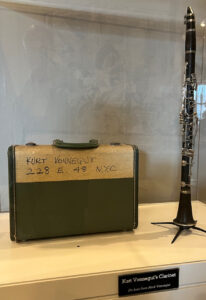
Artifacts from a life, at the Kurt Vonnegut Museum & Library. (Photo by John Griswold)

Tools of Vonnegut’s trade, in the KVML centennial exhibition. (Photo by John Griswold)
More importantly, the National Register of Historic Places Inventory says, “The Indiana Avenue Historic District is significant because it contains the city’s only evidence of the once-thriving commercial activity that primarily served the black community of Indianapolis. Businesses along the avenue, particularly the 400 and 500 blocks, provided food, housing, entertainment, consumer services and, most importantly, a sense of identity for black residents. […] These structures are an important thread of continuity with the cultural contributions made by blacks to the city throughout the early years of the 20th century.”
Where were the throngs, the street festival, the 24-hour readings, the national press, and rabid packs of university scholars looking for textual meat? The symposia? The mayor and the managing editor of Penguin Random House?
Inside the museum I missed mention of that. There were three floors of exhibits on Vonnegut and his family, banned books, and WWII and the allied firebombing of Dresden in 1945, which Vonnegut famously experienced on the ground as an American POW. His childhood ice box, his clarinet, his typewriter from the 1970s, and an old pair of his eyeglasses were on display. A few visitors walked around looking at exhibits and browsing the small gift shop. A representative from the Eugene Debs Museum in Terre Haute sat at her table near the cash register, confusing things slightly. A quintet was setting up to play upstairs near the snack bar, which was not open, and someone from The Saturday Evening Post had brought an archive of work Vonnegut published in the magazine.
A “Year of Vonnegut” was declared in Indy in 2007, but that was deflated by his death that year. Given the centenary, it seemed as if there should be more going on, and that got me thinking about legacy from the start. There were six other events for the fest: two discussions for books on Vonnegut and one on Judaism and Vonnegut’s story “Adam”; two small concerts related to Vonnegut titles; and a black tie-optional gala. Where were the throngs, the street festival, the 24-hour readings, the national press, and rabid packs of university scholars looking for textual meat? The symposia? The mayor and the managing editor of Penguin Random House?
A few fans had been invited to bring their collections of Vonnegut-related memorabilia to the museum and display them on card tables. Bayard Miller brought a selection of foreign-language paperback editions he likes to buy in foreign cities when he travels, but many were bought online. Miller is Head of Digital Scholarship & Technology at the American Philosophical Society in Philadelphia and had been planning to attend the centenary event for years. He showed me his tattoos, which were copies of cartoon doodles from Vonnegut’s books. His favorite was one from a French edition of Breakfast of Champions.
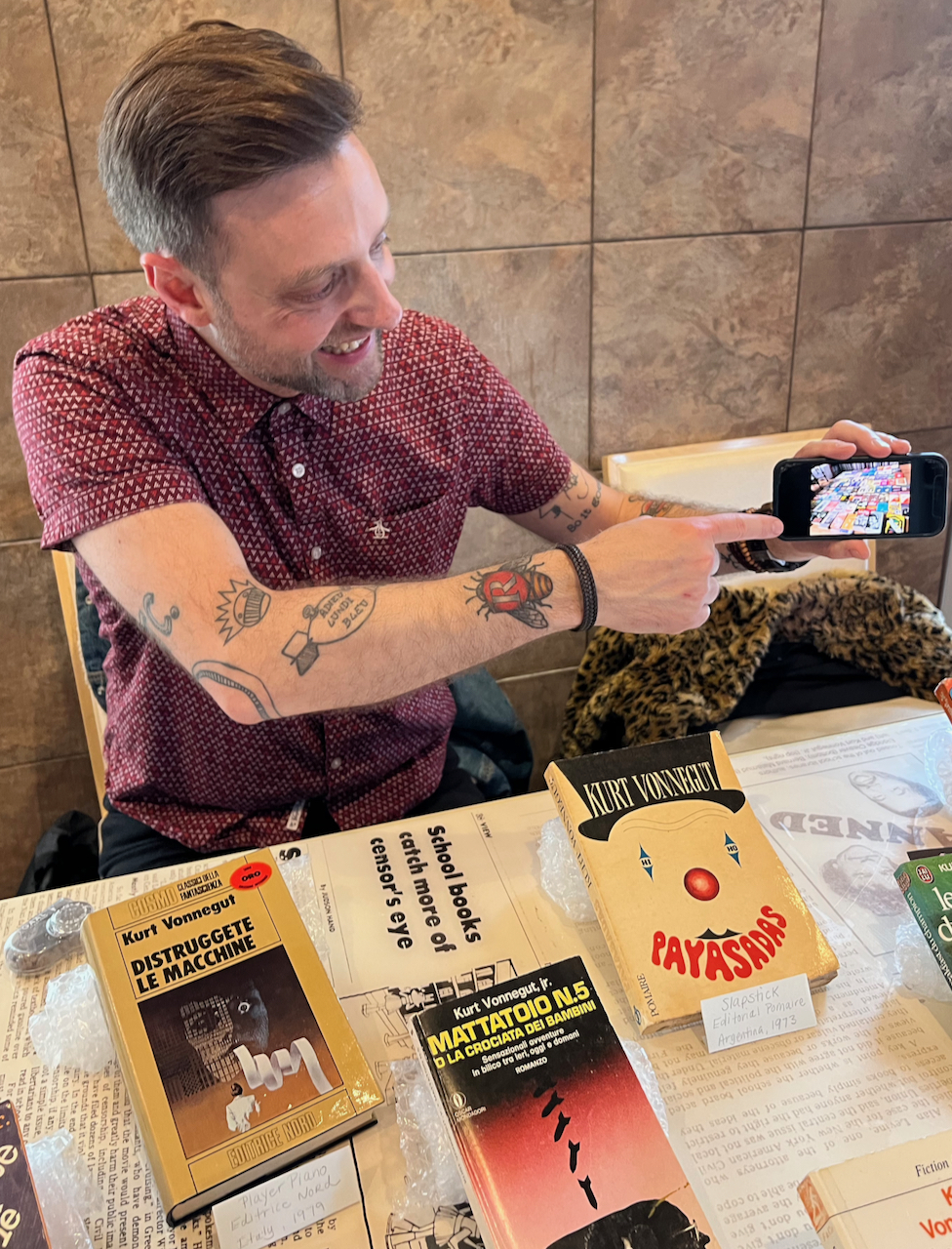
Bayard Miller, Head of Digital Scholarship & Technology at the American Philosophical Society in Philadelphia, brought a selection of his collection of foreign-language paperback editions of Vonnegut’s work. (Photo by John Griswold)
Cartoons are important to the legacy of Vonnegut. The favicon, or browser tab icon, for the museum is the cartoon asterisk of narrator Vonnegut’s asshole, from Breakfast. (In fact the asshole is everywhere and was multiplied like stars on the flyer for VonnegutFest 2022.) Vonnegut’s cartoon of himself in profile is used often as proof of his playfulness, comic sensibility, and the warmness of what local business and development people mean when they refer to him as “Uncle Kurt.” Uncle Kurt is a marketing fiction, of course, as everyone knows and a recent documentary I reviewed here showed yet again. He was in pain, and he caused it in his life. Maybe the asterisk asshole is an adequate icon after all.
But cartoonish Uncle Kurt makes it seem nice to be nice: Shambling, kind-eyed, a smoker’s chuckle, the use of mild blasphemy in his pleas against the violences of history: “There’s only one rule that I know of, babies—: ‘God damn it, you’ve got to be kind.’”
The seemingly gentle tone and simple texture of Vonnegut’s prose makes it popular with the young, which makes him kin to Salinger. He and Salinger were not just of the same generation; they were born only three years apart. Both had odd connections to slaughterhouses, both served in WWII, and both fought at the Battle of the Bulge—with Hemingway, who was older but there as an illegal combatant as much as correspondent. All three suffered mental health issues after the war, though what was latent and what caused by trauma is still argued.
(All wrote about the war, too, and David Shields and Shane Salerno argue in Salinger [2013] that, “The Catcher in the Rye can best be understood as a disguised war novel. …Salinger took the trauma of war and embedded it within what looked to the naked eye like a coming-of-age novel.”)
It was at the Bulge that Vonnegut was captured by the Germans and taken eventually to Dresden, where POWs were used as forced labor in a malt-syrup factory. After the firebombing, when the city was a moonscape, he and other allied prisoners were forced to collect what remained of corpses and were abused by German survivors as they worked.
The seemingly gentle tone and simple texture of Vonnegut’s prose makes it popular with the young, which makes him kin to Salinger. He and Salinger were not just of the same generation; they were born only three years apart.
It was always an odd feature of Vonnegut’s work that one of the grimmest views of human existence—among other things, that the human forebrain is a mistake of evolution that it will correct by extinction—should be so beloved by young readers.
Lev Grossman once recommended Vonnegut’s Cat’s Cradle for teen readers for a roundup in The Paris Review called “Teenage Literature, Wet Brains”:
“I read and reread this book constantly from ages thirteen through sixteen,” Grossman says. “Vonnegut seamlessly merges (sorry for the cliché) the basic existential challenges of life with that early-adolescent sense of generalized grievance against the world of which thirteen year-olds are the chosen curators. Plus, it’s impossible to read Cat’s Cradle as a grownup, so it’s now or never.”
Vonnegut wrote, in a piece collected in the posthumous Armageddon in Retrospect and quoted in a silkscreen on the wall of the museum, that the reason “stuff came gushing out…was disgust with civilization.”
• • •
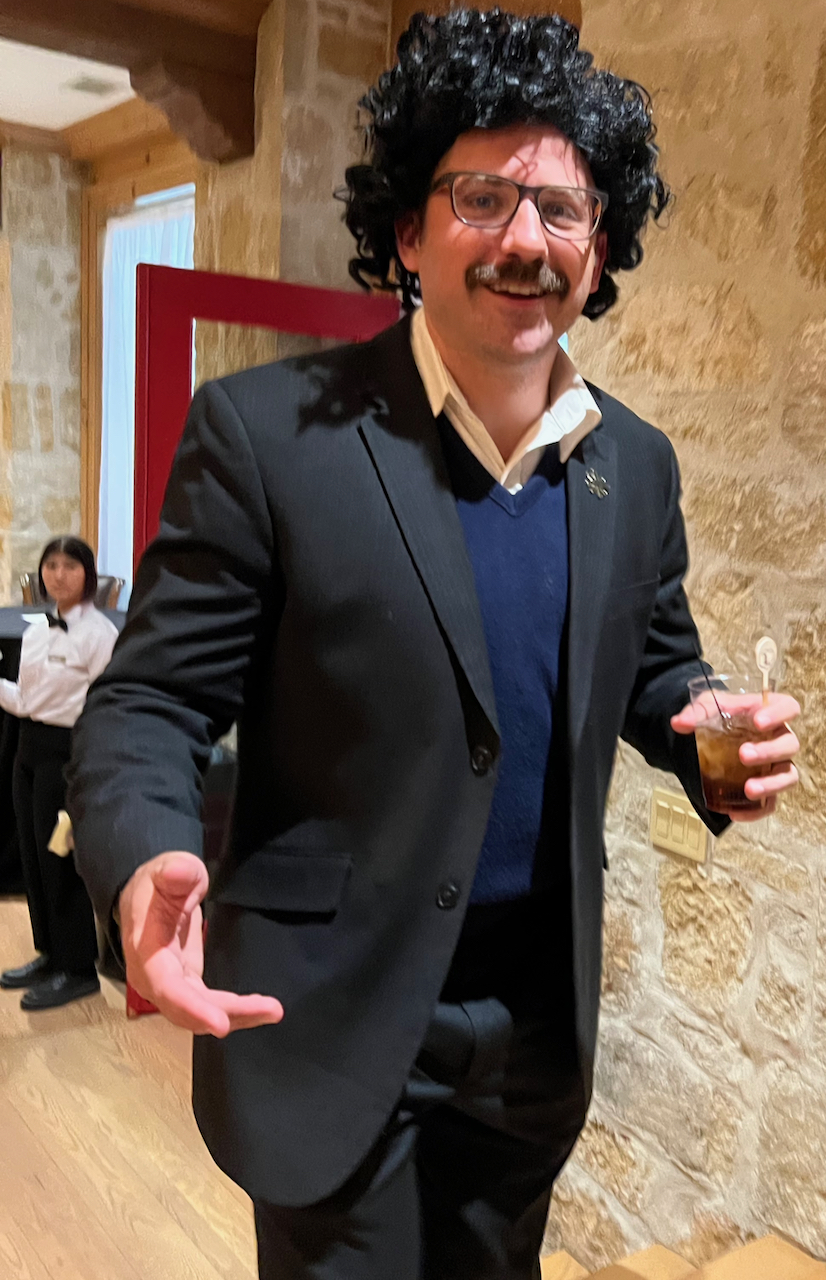
Chris Cecil, as Kurt Vonnegut, works for Visit Indy and is a KVML board member. (Photo by John Griswold)
Though a late starter at 21 or 22, I was one of those young readers and became a completist for Vonnegut’s books to that time. I thought for the centenary I would re-read a couple of the same novels, picked at random, to see what I would think of them now.
Cat’s Cradle (1963) is an unpleasant little book with a strained sense of colonialist satire that does not say what it seems to want to say. There is a lot of anger building in it that will come out more fully in later books. Women are portrayed awfully, and some of the jokes are crude.
It was always an odd feature of Vonnegut’s work that one of the grimmest views of human existence—among other things, that the human forebrain is a mistake of evolution that it will correct by extinction—should be so beloved by young readers.
But its comments on the nuclear arms race have converted successfully, speaking now to our panic over climate change. (An important plot point is the technology of room-temperature ice, called Ice-nine, which a few humans hoard and hide and of course end up using to ruin the planet and kill almost all living things.) The book also invents many of the Vonnegutian words and phrases that fans still love to use, such as karass (a group of people linked cosmically); granfalloon (a false group with no real connections, such as “Hoosiers”); wampeter (the purpose of a karass), and foma (harmless untruths).
“Join the Karass!” says the museum’s trifold brochure.
Cat’s Cradle is Vonnegut’s fourth novel. It makes clear he is a moralist who employs aphorisms and rewrites elements of wisdom literature. He has an imagist sensibility and a popular (often sci-fi) writer’s plot sense. Occasionally he hits it just right, as with his call-and-response prayer (146) for the dying, in his made-up religion of Bokonism, in which human beings are “lucky mud,” more blessed than regular mud “that didn’t even get to sit up and look around.”
“What memories for mud to have!” the last rites say. “I loved everything I saw!”
The homeliness of the image, referencing the clay with which we are formed, as well as the golem-creature’s gratitude, are touching.
I also re-read Bluebeard, another slightly weird novel that went slowly. In this version of the tale, Bluebeard is a fictional Abstract Expressionist painter with a giant house on the shore and too much time on his aging hands. Since he is isolated, much of the book is him talking to us. He has a secret locked up in the old potato shed out back, and his platonic lady companion wants very badly to know what it is. Attitudes about women are not good here either, but that becomes part of the point.
Vonnegut is best with material about WWII and atrocity, which again find their way into this novel published forty-two years after the war. A woman massacred with others in a field has jewels she was trying to save dribbling from her mouth; they create new life. One of the most powerful indictments I have ever read of men’s treatment of women is depicted: Men who after the war thrust their wives’ hands into boiling water for sleeping with the enemy in order to survive. The story is told by a woman who has suffered much but grown powerful, in part by the sale of those jewels.
In Slaughterhouse-Five, “so it goes” has a kind of sci-fi Buddhic intent: that everything exists all at once, forever, like a multiverse, and so nothing is really lost, and suffering means something other than what we think it does.
Then of course there is Slaughterhouse-Five (1969), still powerful and interesting, worthy of legacy, but with a strange I’m done writing this now ending. The main correction to my memory of that book is that I have been wrong in thinking that the constant repetition of “So it goes,” a hundred times, after every death, evil event, and calamity, was just cynical shoulder-shrugging. I remember reading it around the time in my army service that I had a sociopathic roommate who fed live fish to his piranha while giggling and saying, “Oh well.” He said the same thing when he put mice into miniature recompression chambers in the dive detachment, pressed them down to atmospheric depth, then released the pressure instantaneously for explosive decompression.
In the book, “so it goes” has a kind of sci-fi Buddhic intent: that everything exists all at once, forever, like a multiverse, and so nothing is really lost, and suffering means something other than what we think it does. What we humans see as isolated particles of past, present and future, leading inexorably to disappearance into the void, the alien Tralfamadorians see as one thing, as if looking at the entire Rocky Mountains all at once. They recognize suffering, but after all the sufferer also exists in the eternal present as a baby, a teen, and a person at the height of their powers, in joy, in achievement, in love.
In the novel, a clueless professor interrogates Billy Pilgrim, the protagonist, about Dresden.
“It must have been hell on the ground.”
“It was,” said Billy Pilgrim.
“Pity the men who had to do it.”
“I do.”
“You must have had mixed feelings, there on the ground.”
“It was all right,” said Billy. “Everything is all right, and everybody has to do exactly what he does. I learned that on Tralfamadore.” (479)
Vonnegut is often mentioned with postmodern fiction writers such as John Barth and Donald Barthelme, especially for his metafictional tendencies. The main thing I note about Slaughterhouse now is its insistence, as if trauma-dazed, that our attempts to make meaning by narrative do not mean much. Put another way, this is a novel that has lasted for decades and will likely survive longer, even though it undercuts its presumed purpose. So it goes.
• • •

Painter Kyle Ragsdale finishes a canvas for the live auction. (Photo by John Griswold)
The next night, November 12, was the centennial birthday gala, held at the Lucas Estate, to honor the legacy of Vonnegut. Its real purpose was to raise $100,000 for the Kurt Vonnegut Museum and Library, which did not seem like too much to ask. Tickets started at $500. There would be a 1920s theme, live jazz, an auction, and dinner.
The Lucas Estate, its promotional copy reads, is “considered to be by many the most magnificent residential estate in Indiana. The property, formerly known as the Hilbert Mansion (also known as Le Chateau Renaissance), sits on 33.6 acres within the City of Carmel, just north of Indianapolis. The property, originally built by Stephen Hilbert and his wife Tomisue, is reminiscent of a French Country Manor fit for a member of the aristocracy.”
A half-mile brick driveway through a groomed landscape and past gate houses led to a long white event tent. It was freezing and icy, and there was no heat in the tent, but two men worked the arms on a 10-foot, aging-Vonnegut puppet, which stood next to a very old Stutz motorcar. Past the tent was the entrance to a castle-like building, where there was a bar, dining room, and a silent-auction room. Chris Cecil, who works for Visit Indy and is a KVML board member, was greeting arrivals dressed as a Kurt Vonnegut impersonator, which is to say he had a real moustache and wore an Einstein wig. Writer Tim O’Brien was at the bar chatting with people. The Stacey Kent Trio played on a stage in the dining room.
The main thing I note about Slaughterhouse now is its insistence, as if trauma-dazed, that our attempts to make meaning by narrative do not mean much. Put another way, this is a novel that has lasted for decades and will likely survive longer, even though it undercuts its presumed purpose. So it goes.
Artist Kyle Ragsdale, who told me he had been featured on HGTV’s Good Bones, was painting a canvas that would be auctioned later that night. I asked what the painting meant to him, and he said he would tell me a Vonnegut quote: “People are animals, but special animals.” He said his painting was a mix of people and animals “looking on judgingly.”
Greg and Jane Castanias, from Oakton, Virginia, were waiting for the festivities to start. He wore a double-breasted tux, she a flapper dress and boa. They told me they had been friends of the museum for a while and that he grew up in Indiana.

Greg and Jane Castanias, of Oakton, Virginia. (Photo by John Griswold)
“My dad bombed Dresden, among many other things,” Greg said. He said his father flew “35 missions over Nazi Germany in a B-17.” He thought his dad knew about Vonnegut being on the ground but never talked much about his wartime experience. His dad passed in 2011 and never met Vonnegut. So it goes.
Greg said he knew the writer’s surname growing up, because Vonnegut’s grandfather had built so many houses on Meridian Street, and there was a Vonnegut hardware store in Indy for 113 years.
“Then I found out there was this famous writer,” he said, “and I wanted to learn more.” Greg met Vonnegut once, when Greg “took a vanful of English majors from Wabash College to Fort Wayne to hear him speak.”
“And you’re fans of his writing, of course?” I said.
“Oh yes, oh yes,” Greg said.
“What’s your favorite book?”
Jane said she always gives the “boring” answer, Slaughterhouse. “You probably have a more sophisticated…,” she said to Greg.
“Well, for obvious reasons I like Slaughterhouse-Five,” he said. “But I’m also a big fan of his nonfiction writing, like Palm Sunday, and I honestly don’t remember the name of the last book he published, a smaller book of essays, but I have a very vivid recollection of waiting for a flight in the old LaGuardia terminal for the shuttles and reading that book from cover to cover on a flight delay.”
“I think everybody could benefit from his message of kindness these days,” Jane said.
Chris Cecil, who works for Visit Indy and is a KVML board member, was greeting arrivals dressed as a Kurt Vonnegut impersonator, which is to say he had a real moustache and wore an Einstein wig.
During dinner there were a series of rallies, taped segments, and speakers. Tim O’Brien was interviewed onstage. He said Vonnegut had been a hero of his since he had served in Vietnam, and because both were combat infantrymen, both saw massacre or its aftermath (O’Brien served in the province where My Lai had occurred a year earlier), and both were “bedecked with a Purple Heart,” they “lived kind of parallel lives.”
When his novel Going After Cacciato (1978) won the National Book Award, O’Brien’s publisher asked, “Who do you want to come to dinner for the celebration at a fancy restaurant in New York called Elaine’s?” O’Brien wanted Vonnegut, who came.
“The sad part of the story is,” O’Brien said, “my mom and dad were there, and Vonnegut was beside me at this restaurant. My dad was on the other side, and they were of exactly the same age, and my dad had been a veteran in WWII as well…. And they had so much in common they spent the next four hours talking to one another, and ignoring me!”
The crowd laughed.
“This event was to celebrate this incredible event in my life, and my dad kind of usurped me.”
Later the two writers met several times at publisher events. O’Brien said Vonnegut was “so kind to me, and so supportive. […] He was a man who was deeply moral in a personal, everyday sort of way. He was nice to rude waiters, and to people you would want to be the opposite of nice to. He was polite. There’s that sign on the bottom of the Museum and Library that says, ‘A saint is a person who is decent in a shockingly indecent society.’ That was Kurt Vonnegut personally.
“He had a cold side, and a hard side. He was a serious literary man, who was able to do incredible literary things with language…he was a genius in many ways. That’s why I’m here. I’m celebrating a great writer but also a wonderful human being.”
“I think if Vonnegut were here, he’d feel pretty much as I do right now: I want to be elsewhere. I want to be outside with my cigarettes, which I’m sure as soon as this over I’m gonna skip dinner and go outdoors. It’s what Vonnegut would do, smoke like a whole pack of cigarettes.
When his novel Going After Cacciato (1978) won the National Book Award, O’Brien’s publisher asked, “Who do you want to come to dinner for the celebration at a fancy restaurant in New York called Elaine’s?” O’Brien wanted Vonnegut, who came.
“A writer leads a lonely and arduous life,” O’Brien said. “You spend in my case, and I’m sure in his…maybe seven, eight, ten, hours a day, every day, including the birthdays of my children and my wife, working. And we’re not public people by nature. Probably private people because our writing requires a kind of loneliness, a kind of darkness around us, a sense of us communing with language and with the spirits of prose. You might even say the gods of prose. And as much as his writing—I wouldn’t say influenced me as [much as] impressed me, and made me want to clap my hands in applause—it was the human being that I really came to love. I think that was the main influence.”
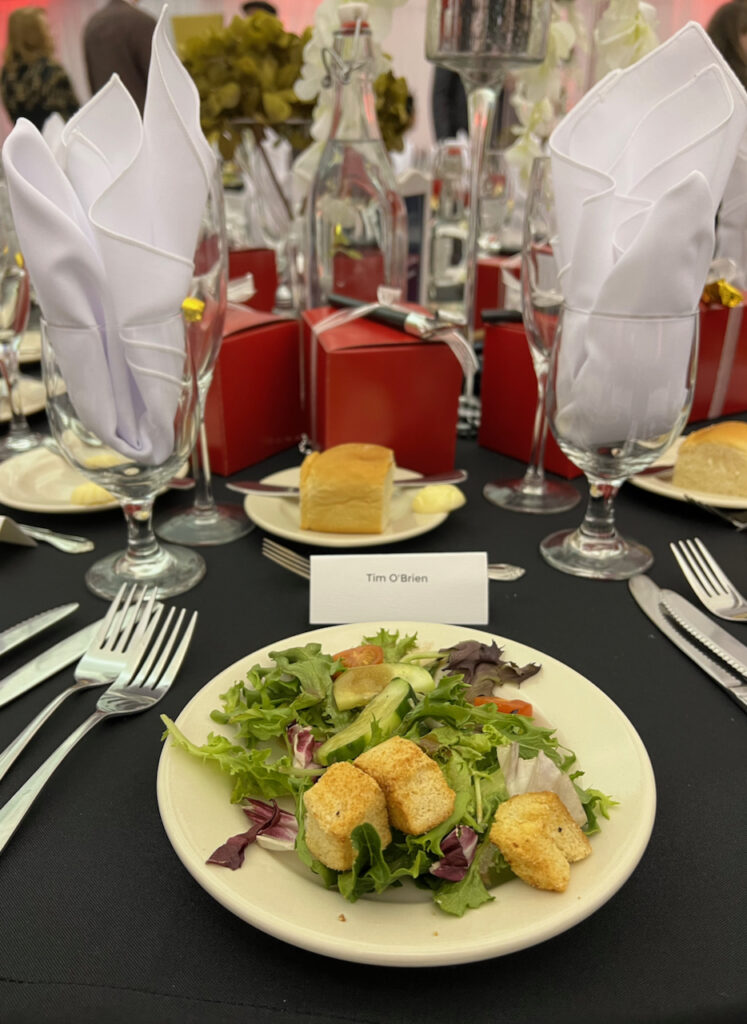
(Photo by John Griswold)
O’Brien said it was hard to write about war, especially in the context of Dresden or My Lai, “and have a soldier say, ‘Oh, poop. I’ve been shot.’ That ain’t real. And Vonnegut felt the same way. There are times in life when you have to be allegiant or faithful to obscenity. The obscenity of a massacre you’re not going to render in polite language. Otherwise you’re being a liar. And I think he felt it was his obligation, and it certainly feels it’s my obligation, to be faithful to the world we live in, with all its cruelties and racism and sexism…. Let the world clean itself off, and then we’ll clean up after ourselves.”
• • •
The press table had empty seats. In addition to me, there was a blogger who was a poet, a person writing a memoir, and someone who had been told to sit there because her daughter was running the sound table for the event. All of us looked nervous when an MC asked if everybody had their phones and wallets, because we were going to need them for the fundraiser that came next. It was the birthday of Julia Whitehead, founder and CEO of the KVML and author of Breaking Down Vonnegut, who said the museum’s budget needed $100,000. Half that had been raised already by donors and board members, so they needed to raise $45,000 this night.
“Let us empty our wallets,” an older man said, “by pledging $50,000 among all of us, and we’ll make a great happy birthday present for you, Julia, won’t we?”
A man asked if someone would like to start us off with $10,000.
“Well, I would like to,” a woman who was not a journalist at the press table said.
“How about 7500?” the man asked. There was an uncomfortable pause, the clearing of throats. “Did dinner not agree with you?” he said. “Well, somebody pledge something, let’s get started.”
Someone shouted the number 5,000, and there were cheers and applause from relief. Within a minute or so we were halfway there. Someone acknowledged that many of the donors so far knew each other from the Ivies. “I’ll take a contribution of $5,000 from somebody who couldn’t get into Harvard,” a man said. Another talked about the books “we either did or didn’t read 40 years ago.”
A lot of the dinner crowd had beat cheeks by then, but the bidding reached $46,663 easily and quickly, exceeding the goal, so then it was time for Marilyn. I had asked the stage manager earlier, seeing what was coming, why Marilyn Monroe on this centenary—was there a connection to Kurt Vonnegut? She laughed and said she did not think so.
I thought of Vonnegut’s character Nelson Bauerbeck, a representational painter and teacher of figure painting at the Art Student League in Bluebeard. “He was from Cincinnati, Ohio, but had spent most of his adult life in Europe…. He was so old that he had conversed, however briefly, with James Whistler and Henry James and Émile Zola and Paul Cézanne!”
Asked by a prospective student if his portfolio was any good, Bauerbeck said, “It told me, ‘Here is a man without passion.’ And I asked myself what I now ask you: ‘Why should I teach him the language of painting, since there seems to be absolutely nothing which he is desperate to talk about?’”
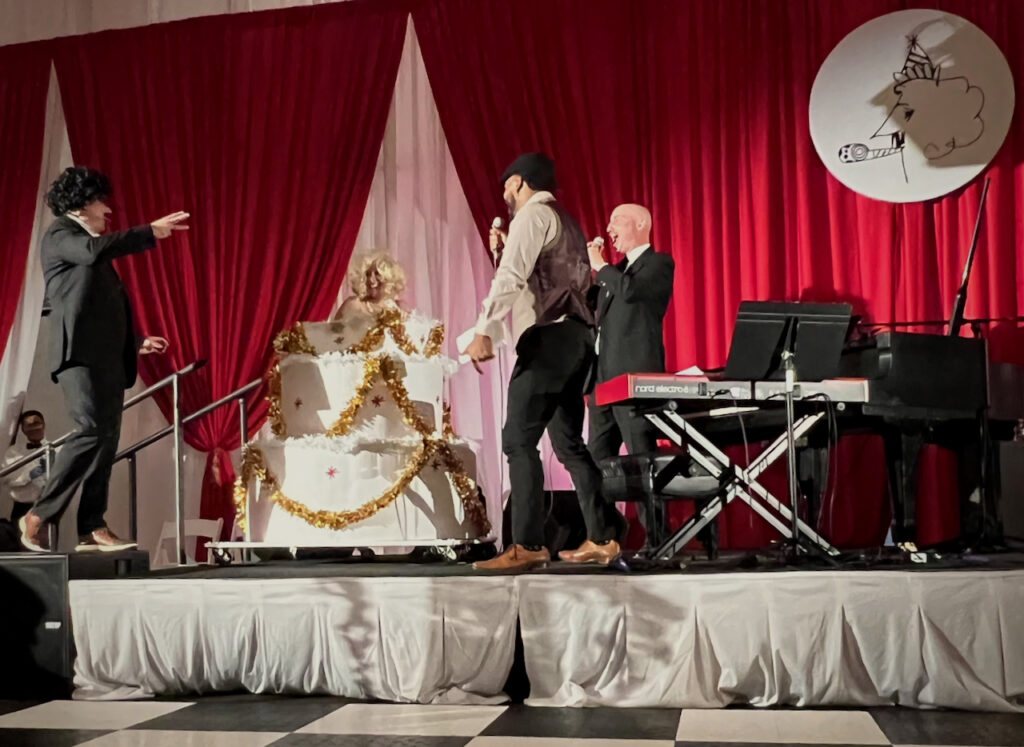
Marilyn Monroe pops from a cake at the end of the gala celebration. (Photo by John Griswold)
A lot of the dinner crowd had beat cheeks by then, but the bidding reached $46,663 easily and quickly, exceeding the goal, so then it was time for Marilyn. I had asked the stage manager earlier, seeing what was coming, why Marilyn Monroe on this centenary—was there a connection to Kurt Vonnegut? She laughed and said she did not think so. As far as I can tell now, the only thing Vonnegut and Monroe shared was space in the same issue of Collier’s, and separate rentals of the same two-bedroom windmill in the Hamptons.
But here was Chris Cecil, the Vonnegut impersonator, and another man, waving their hands and laughing around a cartoonish wooden tier cake on the spotlighted stage, and after a time, a Marilyn impersonator in a terrible wig eased up awkwardly from the inside of the fake cake, and the remainder of the crowd applauded. Tim O’Brien, part of the same Death and Art Club as Vonnegut, was long gone, headed out with his smokes for the day’s remaining writing hours.
